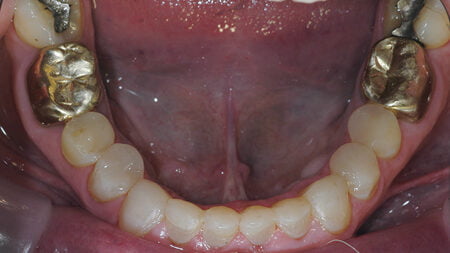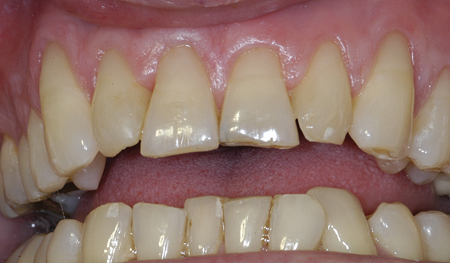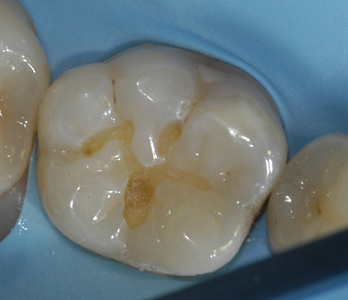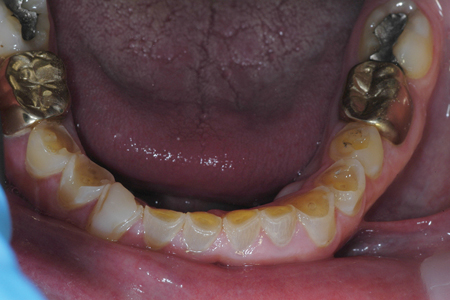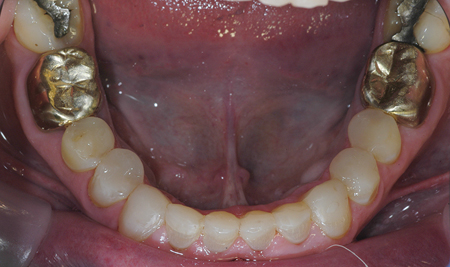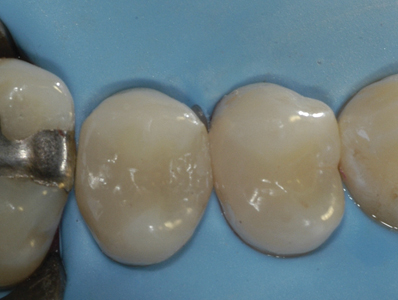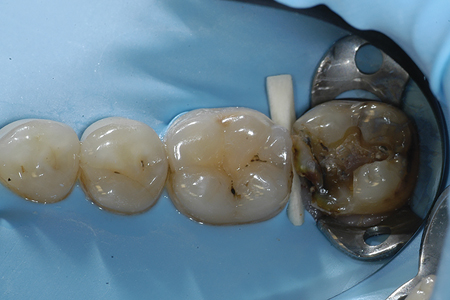[ad_1]
After we full a resin restoration, we hope that it’s going to final, be engaging, put on properly, retain its polish, keep shade, reject extrinsic stain, and never fracture (Figs. 2 & 3) Resins at this time quantity within the a whole bunch. Whereas most are clearly superior to the handful accessible at first of the adhesive period, we stay considerably at the hours of darkness about how to decide on amongst them.
Fig. 1
Fig. 2
Fig. 3
Finally, as clinicians, we distill a day by day suite of resins from this discipline of a whole bunch, selecting, for sensible causes, solely a small subset. Our easiest scientific portfolio typically entails a posterior resin with excessive flexural energy and masking capability, and an anterior resin with decrease energy however higher mixing capability and better gloss. (Fig. 4) To this, most practitioners add a flowable with good dealing with and excessive radiopacity.
Fig. 4
A bulk fill could spherical out the resin armamentarium, or a dual-cure (DC) flowable/bulk fill for light-starved purposes corresponding to deep proximal bins, post-luting, small core buildups, crown restore, and interim therapy.
A small spectrum of shades in these resins completes our suite, workhorses we depend on from pedodontic (Fig. 5) to senior instances, from the smallest easy interventions to grand Herodontic restorations (Fig. 3) and full mouth restorations. (Fig. 6)
Fig. 5
Fig. 6A
Fig. 6B
A whole bunch of different resins are omitted from our palette.
The place will we acquire the knowledge to make this cull? Within the Age of Information, it appears an irony that when reaching for resins, we do not need comparative knowledge at our fingertips. There are dental journals that publish useful knowledge, however nowhere is it complete.1,2,3
Twenty years in the past, this creator compiled a spreadsheet of 40 composite parameters for 40 resins from copious correspondence to producers, as a foundation for suggestions to review membership members. This concerned 1600 potential knowledge factors, a really laborious job, which is now out of date, as a result of these resins have been outdated. The work on at this time’s choices stays undone. For on a regular basis observe, what rational foundation is available to information one’s remaining alternatives from the resin lottery?
Factually, we do know that resins differ extensively of their parameters. For instance, flexural energy varies as a lot as 400%, polymerization contraction 250%, particle measurement 1000%, elastic modulus (additionally known as flexural modulus) 700%. Remedy stays invisible however an absence of curability generally is a severe downside as seen when evaluating two comparable resins. (Tables 1 & 2).
Desk 1: Curing Time for Gingival wall Increment

Well-liked resin with glorious gingival photoconversion (From Actuality Publishing).
* Exceeds 80% objective.
Desk 2: Curing Time for Gingival wall Increment
Clearly, with such a ramification of variables, a lot may be gained by totally understanding the scale of the resin one is utilizing. From scientific expertise, practitioners can anecdotally tie outcomes to those parameters. However that isn’t science. True scientific technique is based on goal measurement. Sadly, correlations with measured values and scientific efficiency haven’t been a analysis focus.
Inside every resin formulation, these 40 parameters, measurable and distinct, are beneath a producer’s management. From a trial pattern we are able to assess exterior components: dealing with, esthetics, opacity, polish, and ease of ending. Nonetheless, the deeper facets of formulation can solely be guessed at. “Attempt it Physician, you’ll adore it…” is obtainable at level of sale.
The scientific questions are, “Which parameters matter probably the most and what do they predict?”
As a long-term research membership mentor, I’m routinely requested what resin I take advantage of. My abstract opinion is: “The most effective posterior outcomes are obtained utilizing a resin with a flexural energy exceeding 150 MPa ( from a 3-Level take a look at, not a 4-point take a look at), a flexural modulus approaching or exceeding common dentin (10 to 12 GPa), with a curability beneath 20 Joules, a end exceeding 95 Gloss Models (95% of incident mild is mirrored again to the human eye), over 80% stuffed by weight, with a largest particle measurement beneath 30 microns, lower than 2% polymerization contraction, excessive molecular weight polymer, low-slump, adaptable viscosity, lack of stickiness when heated, shade stability, free from extrinsic stain acquisition or intrinsic shade change, and better than medium opacity to cover sclerotic or amalgam-stained dentin.”
I’m conscious that maybe half of this short-list of variables could also be unavailable to most dental practitioners and incomprehensible to many even when it was.
Attempt to think about how our practices may very well be completely different if a “Resin QR Code” (Fig. 1) accompanied every product, and an identical App was accessible for its interpretation. It will present a measuring stick to tell practitioners, upfront of trial or buy, the composition of every resin.
Think about this: producers know these components, why can’t we all know them too? Their product, which is delivered to market, is what they contemplate their finest mix of interactive properties. However are they finest for the scientific therapy we’ve at hand? Are there weaknesses we have to compensate for in scientific placement? If we purchase larger depth of understanding, dialing within the properties to the scientific want, can we reliably develop our profitable vary of resin dentistry?
A universe of trial and error, blind product loyalty, and mysterious outcomes may very well be swept away, together with the painful means of sustaining credibility whereas explaining to a affected person why therapy is failing. (Fig. 7)
Fig. 7
BREAKING DOWN THE VARIABLES
Resin properties might be organized into two classes:
- These that may be perceived by the operator
- People who can’t
1: VISIBLE PROPERTIES
Primarily seen components, accessible by means of use, embrace:
ESTHETIC PROPERTIES
- Shade constancy at placement: is A3 truly A3?
- Mixing/translucency – additionally known as “metamerism” (Fig. 8)
- Opacity to cover darkish tooth construction (Fig. 9)
- Extrinsic stain acquisition
- Polishability gloss (GU) as a p.c of mirrored incident mild after polish (100=mylar,50= matte) related to look and to Class V tissue acceptance (Fig. 10)
- Fluorescence
Fig. 8
Fig. 9
Fig. 10
HANDLING PROPERTIES
- Viscosity = firmness/softness to condensation
- Tendency to cohere vs granulate in placement
- Stickiness/pullback to placement devices
- Response to chairside heating (Fig. 11)
- Droop
- Tack
- Thickness of oxygen inhibited layer
Fig. 11
FINISHING PROPERTIES
- Tendency to boring ending carbides: an overhead value issue when burs boring too rapidly
- Tendency to “load” or clog burs
2: INVISIBLE PROPERTIES
Invisible components are way more quite a few than the previous and are vital for scientific sturdiness. These can be found solely as knowledge and can’t be perceived with human eyes and fingers.
- Flexural energy: whereas dentin lies between 200-250MPa; resins are 100-187. The numbers on this vary represents an business commonplace, derived from a 3-point take a look at. A 4-point take a look at exists however delivers a distinct numerical worth
o This drives suitability for mild/medium/heavy purposeful load, and survival of marginal ridges (creator’s opinion=AO) from 45 years of observe and research - Compressive energy. Nearly all resins exceed 350 MPa, together with most flowables. Amalgam lies between 350-500MPa. Subsequently, not clinically discriminatory (AO)
- Flexibility: elastic or flexural modulus in GPa: dentin is 12-16, enamel is 80. Paste resins are normally 9GPa or larger, flowables are usually 4 to 9 GPa
o Excessive modulus, 9-18 GPa are appropriate for posterior software (AO)
o Low modulus, 5 to 9 GPa, signifies suitability for abfractions (AO) - Polymerization contraction, starting from
o Below 2% in the most effective paste resins
o Over 5% in flowables. Contraction interfaces with flexural modulus to foretell post-operative crazing and white line formation (AO) - Creep
- Hardness , reported in three completely different scales; Barcol, Knoop, and Brinell
- Put on = microns per yr, common; enamel is 15-25. Common put on is just revealed by means of scientific trial analysis or laboratory testing by means of accelerated growing old protocols
- Put on is vital to the sturdiness of a full mouth composite reconstruction of a bruxing affected person/ (Figs. 12 & 13)
- Abrasiveness towards denture enamel, which correlates with largest particle measurement (AO)
- Level load tolerance. Relevent to occlusions with sharp cuspal morphology(AO). (Fig. 14)
- Thermal enlargement: the nearer to tooth construction, the higher, to scale back cyclic pressure to bond interface
- Radiopacity: as mm. of aluminum equal. Generally understood
- Resin molecular weight. Greater is best (AO)
- Water absorption. Much less is best (AO)
- Solubility: clearly, we want our restorative supplies to be as insoluble as doable, not solely to keep away from their dissolution but additionally to keep away from transport of constituents into the human physique
- Sturdiness to chemical assault, for instance from alcohol, ketones and different natural meals constituents
- Biocompatibility of natural compounds
o Allergenicity
o Mutagenicity4
o Apoptosis, a measure of decreased intracellular respiration, for instance, solely accessible by means of research of immortal cell cultures4 - Particle loading by weight and quantity
o Largest particle
o Smallest particle
o Plucking resistance
o Particle floor coating and particle fillers (silica, zirconium, barium glass, yrbettium trifluoride, and many others. This data guides the necessity for primers in composite repairs.
o Biocompatibility of fillers as an occupational publicity and affected person well being issue - Microbubble inclusions at manufacture; this will likely differ from 0.5% to over 2%. That is a lot larger than what one would count on and differs extensively from product to product5.
- Curability for every shade, expressed as Joule requirement to 80% on the gingival ground, normally primarily based on hardness, relative to 100% on the occlusal floor (Desk 1 & Desk 2)
o Catalyst system for every shade
o Optimum curing wavelength
o Rapidity of treatment at really helpful publicity. Gradual polymerization could also be higher for some purposes, and will relate to crazing of skinny residual tooth construction if flexural modulus is excessive (AO)
o Depth of treatment, in mm. at really helpful publicity
o Distance restrict for curing tip- to- resin photopolymerization. This guides the necessity to resort to Twin Remedy (DC) or Self-Remedy (SC) resins in deeper proximal bins, for instance - Polymerization contraction. Preliminary and subsequent after 5 seconds, 10 seconds, and 5 minutes. Producers can quote values from early-stage contraction to realize market benefit (Desk 3)
- Extent of treatment of DC supplies in DC mode alone and never mild cured after placement.
Fig. 12
Fig. 13
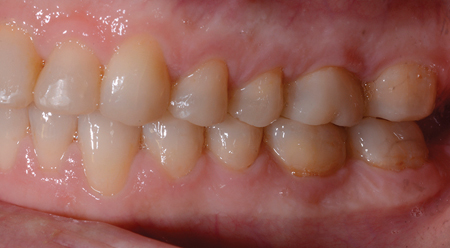
Put up-op full mouth composite rehabilitation. Few resins are each beauty and have the capability for these hundreds.
Fig. 14
Desk 3:
3: SHELF LIFE
Lastly, for efficient observe administration and overhead management we’d like to concentrate on product deterioration, corresponding to:
- Degradation variables, corresponding to catalyst expiry if refrigerated or not
- Absorption of atmospheric moisture
- Deterioration from chairside heating
These components type a pyramid of measurable variables which have a bearing on the probability of scientific success, corresponding to Class II fracture in a affected person who bruxes (referring to flexural energy (AO)), or Class V enamel margin survival in a clencher who abfracts his/her CEJs (referring to flexural modulus (AO)).
They allow predictive energy for a affected person whose resin-restored decrease pure dentition occludes towards an acrylic full denture (largest particle measurement). They set up limits to our expectations when making a five-surface shoed-cusp Herodontic resin masterpiece (curability, adaptability, voids and flexural energy). They decide issue of placement, possible increment measurement, ease of ending, final gloss, mix or opacity of shade, pace of placement, and in the end affected person satisfaction, and observe profitability. They enlighten reverse-engineering composite failures: breakage, untimely put on, misplaced coloration constancy, poor polish. With knowledge we could choose if it was preliminary resin inadequacy or was it improper placement. (Fig. 15)?
Fig. 15

Reverse-engineering fractured marginal ridge in a non-bruxing affected person: Undercure? Inadequate proximal quantity? Pinpoint proximal contact?
Or weak resin?
RESEARCH COMBINED WITH PARAMETERS WILL PREDICT CLINICAL OUTCOMES:
Till we’ve knowledge, the career can’t analysis relevance to scientific outcomes. These correlations are neither clear nor consensual. Take the case of two clinically comparable resins; one has a flexural energy of 110 MPa, the second 220 MPa? What purposes require the upper flexural energy? Conversely, what does excessive compressive energy predict when it so just like amalgam?
What’s the relationship to general resin approach? Can superior resins forgive flawed restorations corresponding to pinpoint contacts and excessive occlusion? Can benign contraction overcome white line as a result of improper margin design in preparation? Will a resin with an exceptionally low put on charge nonetheless present a passable scientific service life if poorly cured and skinny? Will excessive flexural energy override failure to take away stress risers created by sharp inside type? Does resin heating or the dearth thereof decide if resins ship as properly clinically as beneath laboratory situations?
At the moment, solutions to those types of questions are the anecdotal end result of scientific expertise.
ISSUING A CHALLENGE TO THE PROFESSION:
Frankly, in the intervening time we endure profession-wide design deficiencies. We don’t have the info, we don’t know what to foretell if we did have it, and preparations should not standardized.
The definitive textbook of composite technique has but to be written. We’re skilled by dental colleges who develop an in-house consensus. That is not at all commonplace throughout the continent, both in type or in instrumentation. Even so basic an element as preparation design differs extensively between universities. We prepare in remoted domains.
Historic rules from the stolid universe of GV Black methodology have morphed right into a fluid continuum of dissimilar adhesive ideas. Preparation design has develop into depending on the place we skilled and the place we observe, not a common foundation.
This quasi-scientific method achieves no commonplace of care, a serious downside when regulatory our bodies have to re-train practitioners whose composite resin outcomes are the topic of complaints. Career-wide surveys proceed to point issues, corresponding to reported in Clinicians Report in June 2018, highlighting recurrent decay seen by 43% of clinicians inside 2 years of resin placement.1 A repeat survey, 4 years later, in February 20221 equally discovered that put on, fracture and recurrent caries have been regularly seen. 4 years have passed by, no progress. We should admit that each one shouldn’t be properly within the composite resin world.
We require a greater roadmap by means of the largely invisible world of resins, each for the person practitioner and for the career. In the mean time, we hearken to gross sales reps, seek the advice of with a colleague down the corridor, learn a evaluation of 5 good factors in a resin’s formulation, overlook the opposite 35 parameters, after which proceed by trial and error. All the things composite resin that fails clearly wanted a crown, not a greater resin or a greater engineered preparation design and extra applicable resin.
We have to pull up our collective bootstraps; a framework akin to a QR code with an accompanying interpretive App is required to intelligently information our resin choice.
With out knowledge, scientific analysis can’t set up correlations to scientific outcomes. With out baseline correlations, science can’t be delivered to bear on preparation design.
The general public desires to consider we’re able to sound, credible, and reproducible therapy, assembly an outlined commonplace of care. Taking management of the Wild West of resins is a vital first step. From this we are going to derive the power to correlate scientific outcomes. Then and solely then can we rationalize, take a look at, and standardize preparation kinds.
There may be arduous and detailed work forward if we want to convey science to resin therapy and optimum service to sufferers. QR Code, Gents, Please Begin Your Engines.
Oral Well being welcomes this unique article.
References
- CLINICIAN’S REPORT https://www.cliniciansreport.org/
- DENTAL ADVISOR https://www.dentaladvisor.com/
- REALITY RATINGS AND REVIEWS https://realityratings.com/
- J Biomed Mater Res. 1998 Sep 5;41(3):474-80.Cytotoxicity of 35 dental resin composite monomers/components in everlasting 3T3 and three human major fibroblast cultures.Geurtsen W, Lehmann F, Spahl W, Leyhausen G.
- Actuality Yearbook 2012, Actuality Publishing ppg .296 to 399
Concerning the Creator
 Peter Walford is a longtime mentor of stay and digital research golf equipment in composite approach and adhesive prosthodontics. He practices on a gulf island in British Columbia, builds racing sailboats, and operates a small natural farm along with his spouse. pwalford@telus.net
Peter Walford is a longtime mentor of stay and digital research golf equipment in composite approach and adhesive prosthodontics. He practices on a gulf island in British Columbia, builds racing sailboats, and operates a small natural farm along with his spouse. pwalford@telus.net
[ad_2]
Source link

